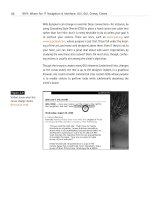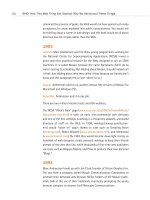Taking Your Talent to the Web: A Guide for the Transitioning Designer- P3 pdf
Bạn đang xem bản rút gọn của tài liệu. Xem và tải ngay bản đầy đủ của tài liệu tại đây (293.92 KB, 20 trang )
On the Web, linear motion gives way to user emotion. Site visitors link ran-
domly as they choose. Set up as many careful hierarchies and navigational
cues as you want; visitors will still do what they like on most sites. Not only
may visitors move up, down, and sideways, they also can bookmark any
page they fancy; download it to their hard drives; save the images from it;
and even study the HTML markup with which it was produced.
Readers can order books on the Web by typing in HTML form fields sup-
ported by scripts written in Perl, Java, or other programming languages
(www.amazon.com). They can post their opinions to message boards
(www.metafilter.com). If the designer has given them the option, they may
change the background colors to suit their mood (www.camworld.com). On
fancy Dynamic HTML (DHTML) sites, they can drag images from place to
place (www.dhtml-guis.com/game/). On fancier ones, they can do much
more (www.assembler.org). On a corporate intranet site, employees may
spend hours updating a group calendar or adding phone numbers to a con-
tact database. (Anything to avoid working.)
21
Taking Your Talent to the Web
Figure 2.3
Non-commercial interac-
tivity: Assembler.org was
created with DHTML (here
it is done well). As of this
writing, the site was opti-
mized for Netscape and
Microsoft’s 4.0 browsers,
which rely on proprietary
coding techniques. Thus
the site’s marvels would
be invisible to users of
recent browsers that avoid
proprietary, old-school
DHTML. By the time you
buy this book, the site
should function well in
standards-compliant
browsers such as Netscape
6 (www.assembler.org).
04 0732 CH02 4/24/01 11:15 AM Page 21
22
WHY: Designing for the Medium: Web Physics
Figure 2.4
Commercial interactivity:
Barnes & Noble, a func-
tional and attractive
shopping site. Successful
e-commerce sites work in
as many browsers as pos-
sible and add value to the
commercial transaction by
providing content and
artificially intelligent
“shopping tips.” Though
Barnes & Noble has a
real-world heritage,
Amazon.com dominates
the online market because
Amazon came first. When
web brands are effective,
users can be incredibly
loyal (www.bn.com).
There is obvious commercial value to commercial interactivity; novelty or
“proof of concept” value to dynamic artwork and games; branding value to
interactive multimedia (www.barneys.com); and hidden value to still other
types of interactivity. (Changing the background color may seem trivial to
you or me, but it could be vitally important for a color-blind web user.)
Overall, interactivity is a defining characteristic of the Web and thus of web
design. Lesbian poetry and physics papers did not drive the rapid expansion
of the medium. Commerce did that, and commerce depends on interactiv-
ity: the visitor clicks, the sale is made.
No offense to the lesbian poetry sites. In fact, no offense to the hundreds
of thousands of noncommercial sites that bring richness, depth, and mean-
ing to the Web. Without these noncommercial sites, the medium would be
nothing more than a dialup variation on the infomercial. But without all
the commercial sites, the Web’s infrastructure, services, and rate of adop-
tion might never have grown so quickly.
At least, that’s what the marketers tell us. Consider this another
Mars/Venus variation for your pleasure. The Internet grew in popularity for
at least two years before any commercial sites were allowed on the Net,
04 0732 CH02 4/24/01 11:15 AM Page 22
much less the Web. And many defining characteristics of the modern Web
($20 unlimited access dialups, 56K modems, free browsers) were estab-
lished by 1995-96, a time when most web users were also web designers,
and the word “commerce” did not begin with the letter “e.” Still, the Web
has expanded like nobody’s business since business came online. And if you
ask most normal humans who’ve gone online in the past few years why
they bought a computer and signed up for an Internet account, “shopping”
seems to top the list.
Different Purposes, Different Methodologies
It is still possible for a lone web designer or small team to create personal,
artistic, and corporate sites using an image editor, HTML, style sheets, and
JavaScript. But the “lone rider” approach is increasingly rare in the corpo-
rate web development space. Today, teams of specialists with odd-
sounding job titles develop most sites collaboratively. (See Chapter 5, "The
Obligatory Glossary” and Chapter 7, “Riding the Project Life Cycle,” for the
funky titles and the typical web project life cycle.) It is not your job to pro-
gram a shopping cart or develop a database. It is your job to understand
where your work fits into the bigger picture.
As a professional web designer, you will work closely with programmers to
implement the appropriate interactivity in every site. You also might be
called upon to execute rudimentary interactivity yourself—for instance,
writing JavaScript to swap images on navigational menus.
WEB AGNOSTICISM
Design for the Web is also different because the Web is not a fixed medium.
It has no size, no inks, no paper stock. Even your typographic choices may
end up as mere suggestions. That’s because the Web is platform-agnostic
and device-independent. Good web design adapts to different browsers,
monitors, and computing systems. What’s sauce for the goose may not be
sauce for the gander. More literally, what’s Geneva for the Mac may be Arial
for Windows; what’s VBScript for Windows may be error messages for Mac
and Linux users. (So don’t use VBScript to build websites.)
23
Taking Your Talent to the Web
04 0732 CH02 4/24/01 11:15 AM Page 23
Looking at poorly implemented sites, you could come away with the
impression that the Web is a Windows application or even an extension of
the Windows desktop. And there are certainly marketers who’d like you to
believe that. But it just ain’t so.
Berners-Lee and Caillou invented the Web on a NeXT computer. The first
browser ever released was for UNIX, the second for Mac OS. Berners-Lee
envisioned the Web as a completely portable medium—one that could be
accessed not only by every computer operating system (including dumb
terminals), but also by all kinds of devices from hand-held Personal Digital
Assistants (PDAs) to telephones and other common appliances. Slowly and
sometimes painfully, everything Berners-Lee envisioned in 1990 has been
coming true.
To help the Web evolve in an orderly fashion, Berners-Lee founded the
World Wide Web Consortium, or W3C (www.w3.org). It’s a place where uni-
versity professors join engineers from companies such as Sun, Microsoft,
AOL/Netscape, IBM, Compaq, and Apple to hammer out common techno-
logical standards, such as HTML and CSS…and more recently, Extensible
Markup Language (XML) and the Document Object Model (DOM). For a
complete listing of W3C member organizations, see the following web
page: www.w3.org/Consortium/Member/List.
Don’t worry about what the acronyms stand for at the moment. Just dig
the concept: If everyone supports the same standards (or “Recommenda-
tions,” in W3C parlance), then designers and programmers will have the
tools they need to deliver a dynamic and attractive Web that works for any
human being, on any platform or device. Sweet, smart, simple.
Sadly, due to competitive pressures, the desire to innovate, and sheer
cussedness, the companies that make web browsers have not always done
a superb job of implementing commonly shared standards. In fact, until
quite recently, you could argue that their support for these standards was
sometimes downright shoddy. You might even be forgiven for suspecting
that browser makers deliberately avoided fully implementing any standard
for fear that supporting common standards would hurt business.
24
WHY: Designing for the Medium: Web Agnosticism
04 0732 CH02 4/24/01 11:15 AM Page 24
In the beginning of this chapter, we mentioned that the Web was spawned
as a beautiful medium for the delivery of physics papers. And that to deliver
commercially viable sites—sites with some semblance of visual appeal—
web designers felt they had no choice but to “hack” HTML, forcing the
deliberately primitive markup language to serve their aesthetic needs.
Netscape (now AOL) joined web designers in extending HTML beyond its
creators’ intentions.
Initially, the Web was a one-horse town. If you wanted to design a com-
mercial site, you wrote nonstandard HTML that was “optimized” for
Netscape’s browser. Once Microsoft’s browser entered the picture, all hell
broke loose, as two powerful software companies began deforming HTML
in mutually exclusive ways.
Browser development was originally viewed as just another genre of soft-
ware development. Adobe Illustrator competes with Macromedia Freehand
by offering features Freehand lacks. Freehand does the same to Illustrator.
God Bless America.
Similarly, Netscape competed with Microsoft (and vice versa) by offering
functionality not supported by the competitor’s product. Each company
hoped these unique features would seduce web developers into creating
sites optimized for its browser alone.
Eventually, the market split in two. Though a tiny percentage of web users
sported alternative browsers including Lynx, Mosaic, Opera, and Amaya,
basically 50% of the market was using Netscape’s browser; the other 50%
was using Microsoft’s. To create “technologically advanced” sites for their
clients without alienating half the potential visitors, designers and devel-
opers felt obliged to create Netscape-specific and Microsoft-specific ver-
sions of their sites. Clients then paid more than they should have to support
the development of these incompatible site versions. Thanks in part to
protests from groups such as The Web Standards Project (www.webstan-
dards.org) and mainly to the hard work of browser company engineers, sup-
port for common standards is constantly improving—though not without
occasional backsliding.
25
Taking Your Talent to the Web
04 0732 CH02 4/24/01 11:15 AM Page 25
Complicating the issue, many of today’s web standards were yesterday’s
proprietary innovations: things that worked only in one browser or another.
You can’t blame Wendy’s for not offering McDonald’s secret sauce, and you
can’t fault browser companies for failing to implement technology
invented by their competitors.
When Netscape unveiled <FRAMES> (the ability to place one web page
inside another), the technology was widely adopted by designers and
developers. Refer back to Figure 2.3, Assembler.org, for an example of the
way frames work. The bottom frame contains a menu; the top frame con-
tains the content. Clicking the menu changes the content by loading a new
content frame. Both frames are controlled by yet a third document, called
the <FRAMESET>, which links to the frames, establishes their size and posi-
tioning relative to one another, and determines such niceties as whether or
not the user can resize a given frame.
Eventually Netscape brought its invention to the W3C. Much later, it ended
up as part of a temporary standard: the HTML 4 Transitional Recommen-
dation. It took Microsoft a while to support frames, because Microsoft’s
browser developers had to reverse-engineer Netscape’s invention to figure
out how it worked. Ironically enough, Microsoft’s 4.0 browser eventually
supported frames better than Netscape’s.
In 1995, Netscape came up with a programming language initially called
LiveScript and eventually renamed JavaScript. Besides being easy to learn
(at least, as far as programming languages go), JavaScript made web pages
far more dynamic. And it did this without straining the computers used to
serve web pages (servers), because the technology worked in the user’s
browser instead of having to be processed by the server itself—the way Perl
scripts and other traditional programming languages had been. With less
strain on the server, more web pages could be served faster. Thus,
JavaScript was bandwidth-friendly.
JavaScript eventually became a standard, but not before putting Microsoft
at a competitive disadvantage for several years. The latest, “standard” ver-
sion of JavaScript is referred to as ECMAScript, which sounds like the noise
our Uncle Carl used to make in the morning. Don’t worry—’most everybody
still calls it JavaScript, which isn’t exactly Yeatsian poetry either, come to
26
WHY: Designing for the Medium: Web Agnosticism
04 0732 CH02 4/24/01 11:15 AM Page 26
think of it. (ECMAScript is so named because the European Computer Man-
ufacturers Association [ECMA] supervised the standardization process.)
While Netscape and Microsoft invented competitive new technologies, the
W3C worked to develop recommendations that looked beyond the
“Browser Wars.” At times, the W3C seemed to be out of touch with what
was actually taking place in the market. Back then, the browser companies
seemed to be ignoring the W3C. (The irony is that both AOL/Netscape and
Microsoft participate in the W3C and play a vital role in developing the
web standards they have sometimes gone on to ignore.) Today it appears
that the W3C is ahead of what browser companies can realistically deliver
in the next year or two. Indeed, even hardened web designers with years of
experience can feel their innards turn to jelly when reading about upcom-
ing standards proposed by the W3C. (XML Namespaces, anybody?)
The important thing is that there is now a road map for browser compa-
nies, developers, and designers. If you took your talent to the Web in the
1990s, you had no way of knowing what new technologies might come
down the pike, what new skills you would have to learn, and how quickly
what you learned (and designed) would become obsolete. Today we know
which standards have been fully or partially implemented in browsers and
which ones we can expect to work with in the next year or two. As opposed
to the past when Netscape could surprise us by inventing JavaScript and
frames or Microsoft could spring VBScript and ActiveX on us and expect us
to quickly learn and use those technologies, today we know what to antic-
ipate and what to learn to prepare for the future.
OPEN STANDARDS—THEY’RE NOT JUST FOR
GEEKS ANYMORE
We’ll bore you with the details in Part III of this book. For now, it is enough
that you understand three fundamentals of web agnosticism.
Point #1: The Web Is Platform-Agnostic
The Web owes no special fealty to any particular operating system. It is
designed to work in Windows, Mac OS, Linux, UNIX, BeOS, FreeBSD,
OS2, DOS, and any other platform that comes along. This presents web
27
Taking Your Talent to the Web
04 0732 CH02 4/24/01 11:15 AM Page 27
designers with special challenges in terms of gamma, screen resolution,
color palettes, and typography—all of which we’ll explore a bit later in this
chapter. This is one heck of a chapter—we hope you realize that. If you get
tired and want to take breaks, we’ll understand.
At first blush, the programmers on your team would seem to have a tougher
job than you do. How on earth are they supposed to accommodate all those
different operating systems? The answer is, they don’t have to. Browser
companies are stuck with the tough job of supporting all those platforms
(or a limited subset thereof). Web standards do the rest. JavaScript is
JavaScript whether it’s running in Linux or Mac OS. Style sheets are style
sheets whether they’re running on Windows 2000 or BeOS. The more web
standards the browsers support and the more completely they support
those standards, the fewer migraines programmers (and web users) will
have to endure.
You, on the other hand, will continually test your designs for cross-
platform feasibility. You will have to cope with the fact that your favorite
Mac system font is not available on the PC (or vice versa). That those tawny
PC colors look pale as Christina Ricci on the Mac. That the large, bold sans
serif headline that looks so dapper on systems with scalable type and built-
in anti-aliasing (such as Mac OS and Windows 98) may look hillbilly-
homely on platforms lacking those niceties (such as Linux).
What You See Is What You Get (WYSIWYG) programs, such as Macrome-
dia Dreamweaver and Adobe GoLive, attempt to give designers the sensa-
tion of retaining complete visual control over web layouts. It is an illusion.
A vast majority of professional web designers still hand-code their pages.
At the very least, they hand-tweak Dreamweaver- or GoLive-generated
code to accommodate the reality of browser and platform differences.
Browser and platform differences mean that the precise control you’ve
come to expect from publishing programs such as Quark XPress and Adobe
InDesign simply does not exist on the Web. You can bemoan this fact or
learn to create beautiful work that exploits the medium’s changeable
nature and facilitates the needs of millions—perhaps even entertaining
them in the process. Not such a bad trade-off, when you come right down
to it.
28
WHY: Designing for the Medium: Open Standards
04 0732 CH02 4/24/01 11:15 AM Page 28
Point #2: The Web Is Device-Independent
Your work not only has to remain usable on a terrifying variety of computer
desktops, it also may be accessed via Palm Pilots, web phones, and other
instruments of Satan. A year ago it appeared that web designers and pro-
grammers would have to continually learn new and incompatible markup
languages to accommodate this plethora of web-enabled devices. Instead,
the W3C is guiding us toward using Extensible Hypertext Markup Language
(XHTML) and CSS to get the job done. (Don’t panic! XHTML is, more or less,
simply a newer and cleaner version of HTML.)
From www.w3.org/Mobile/Activity:
"Mobile devices are unlikely to be able to use exactly the same markup
as a normal page for a PC. Instead they will use a subset of HTML tags.
The expectation is that different devices will make use of different mod-
ules of XHTML; similarly they will support different modules of style
sheets. For example, one mobile device might use the basic XHTML text
module and the style sheet voice module. Another device with a large
screen might also allow the XHTML tables module."
The W3C website is visually lackluster, unmanageably immense, and writ-
ten in language only a Stanford professor could love. Nevertheless, the
W3C is frequently the voice of sanity in the chaos and frenzy of an ever-
changing, commerce-driven Web. Learn to overlook the site’s lack of visual
panache, and the W3C will be your best friend as the Web and your career
move forward. Which brings us to Point #3.
Point #3: The Web Is Held Together by
Standards
To design websites, you will have to learn technologies such as HTML,
JavaScript, and CSS, which really isn’t that hard. As you grow more adept,
you will become aware of wonderful features offered in only one browser
or another. We advise you to avoid these nonstandard technologies and
stick, as much as possible, to what is supported in all browsers.
You might find yourself working for companies or clients who demand spe-
cial features that only work in one browser. Just say no. On an intranet site
(see Chapter 5), it might be feasible to design a site that only works in IE5,
29
Taking Your Talent to the Web
04 0732 CH02 4/24/01 11:15 AM Page 29
Netscape 4, or what have you, because those who commission the site con-
trol the browsers used to access it. But we’ve heard of plenty of companies
that decided to go public with part of their intranet site—only to discover
that its nonstandard features locked out millions of web users. We also
know an agency that designed an intranet site to take advantage of
Netscape 4’s proprietary DHTML Layers technology. When Netscape aban-
doned this technology in favor of web standards, the company’s IT depart-
ment was unable to upgrade its users to the latest version of Netscape’s
browser, which would have made the site nonfunctional. Who took the
blame for this fiasco: the client who had insisted on using proprietary, non-
standard technology or the web agency that had argued against it? If
you’ve had any real experience as a designer, you’ll understand that the
question is rhetorical.
You can often get away with taking the moral high ground simply by
explaining to your clients that delivering what they request will cost them
25% or more of their potential audience. The disabled are almost always
among the first to be locked out of a site that relies on proprietary tech-
nology. Excluding millions of people from a public site is not exactly a bril-
liant business decision, and ethically speaking, it stinks. Excluding the
disabled is also illegal in many instances, at least in the United States.
Court cases have been fought over it, and the client usually loses. The Aus-
tralian Olympics website was one legal casualty; the cost to the site’s own-
ers would have wiped out poverty in three small South American nations.
If legal and ethical arguments don’t work with your clients, show them the
money.
Technologies such as HTML, JavaScript, and CSS are the building blocks of
web design. In theory, all browsers fully support these standards, deliver-
ing on the promise of browser and platform-agnosticism and offering us a
Web where we can “write once, publish everywhere.” Theory and reality
often diverge. In fact, the divergence between them is more or less the story
of the Web. The good news is that built-in browser incompatibilities are
gradually going the way of the Dodo bird as more standards-compliant
browsers become available.
30
WHY: Designing for the Medium: Open Standards
04 0732 CH02 4/24/01 11:15 AM Page 30
THE 18-MONTH PREGNANCY
In early 2000, Microsoft released IE5 Macintosh edition, a browser that
delivers top-notch support for HTML 4, CSS, and JavaScript, three
immensely important web standards. Soon afterward, Opera Software
released its 4.0 browser, whose principal purpose is to deliver superior sup-
port for web standards. And a month before Christmas 2000, Netscape
delivered Navigator 6, the most standards-compliant browser yet.
To read the preceding three sentences not only induces coma, it also sug-
gests that designers are now free to use nothing but W3C standards in the
sites they and their colleagues create.
Alas, this is not the case. IE5 for Windows currently offers excellent but
incomplete support for standards. IE4, currently the most-used browser on
the Web, has good but still less complete support for standards, and
Netscape 4, still used by millions, offers even less. Sure, users can upgrade,
and eventually they will—but at their own pace.
We call this upgrade period the 18-month pregnancy, based on the time it
usually takes before web users feel compelled to switch to an updated
browser. Web designers and enthusiasts download new browsers immedi-
ately—not so your Uncle Nigel. While you beta-test next year’s browser,
your client sticks with AOL 3. Clients and other normal human beings tend
to use the browser that came preinstalled on their computers. They upgrade
when they buy a new PC. Computer manufacturers tend to install 3.0
browsers (considered stable) when 4.0 models are newly available; they
offer 4.0 browsers when 5.0 models first come out; and so on. IT depart-
ments are equally conservative, tending to view new browsers the way cats
regard changes to their litter. Those who use the Web primarily to shop,
send email, or view pornography may not be aware for months that a new
browser is available, and when they do find out they often don’t care.
The browser upgrade path is slow, thus the transition to a Web built purely
with standards could take 18 months or longer. Some say we will not see
a fully standards-compliant Web before 2003. For the near future, you will
likely find it necessary to employ nonstandard workarounds to address spe-
cific deficiencies in these older browsers. We’ll explain these workarounds
in the relevant chapters on HTML, CSS, and JavaScript.
31
Taking Your Talent to the Web
04 0732 CH02 4/24/01 11:15 AM Page 31
Five years ago, the entire Web was a hack, held together with carpet tacks
and lasagna. We are better off now than we were then. And soon the night-
mare of browser incompatibilities will be a story we tell to bore our grand-
children.
CHOCOLATEY WEB GOODNESS
Having accepted that the Web varies from user to user and browser to
browser, and that this will be true even when common standards enjoy uni-
versal support, let’s move on to consider the medium’s many unique
strengths. If you already consider the Web the greatest thing since gender
differentiation, feel free to skip ahead.
’Tis a Gift to Be Simple
Developing effective web architecture takes great skill. Setting type,
designing images and elements, and laying out pages requires consistent
vision and intelligence. Programming sites that will serve sophisticated and
novice users alike is an art of the highest caliber. But anyone can make a
website. A child of six can learn HTML and begin self-publishing in a mat-
ter of days. No other medium is as easy to learn and produce.
Millions of personal sites prove this point. Many are of interest mainly to
their creator’s immediate family and friends—and that’s okay. But a sur-
prising number offer valuable content and/or sophisticated design. You can
view the vast outpouring of personal pages as proof that HTML is easy to
learn. You also might see in it the unshakable human urge to reach out and
connect with others. You can even view it as an extended experiment in
democracy.
Democracy, What a Concept
Every medium in human history has presented a barrier to access. Writers
have had to convince publishers that their books were worth distributing
(or else build their own printing press, like poet William Blake). Screen-
writers must convince studios to invest millions in their visions (and the
writer is usually barred from the set once the script has been sold). Movie
directors must argue with producers and bankers. Painters need galleries;
musicians need concert halls and record deals.
32
WHY: Designing for the Medium: Chocolatey Web Goodness
04 0732 CH02 4/24/01 11:15 AM Page 32
But the Web presents few such barriers. Buy a computer and a modem, find
a hosting provider, learn HTML and some UNIX filing conventions, and
voila—you are a worldwide publisher! If you can’t afford a computer and
modem, most public libraries, universities, and schools offer free Internet
access. If hosting fees are beyond your means, companies such as Geoci-
ties (www.geocities.com) provide free hosting in exchange for the privilege
of running ad banners on your site. The Web places the virtual means of
production in the hands of virtually every worker. What would Karl Marx
think?
33
Taking Your Talent to the Web
Figure 2.5
The Stinky Meat Project.
On the Web, anyone can
publish anything they like.
Baby, that’s democracy!
(www.thespark.com/
health/stinkymeat/)
Speaking of low access barriers, remember the days when you had to
expensively laminate print proofs of your best work, slip them into a costly
portfolio, and toss them out every six months as your new work made the
old stuff obsolete? Well, forget all that. With a free or inexpensive Inter-
net account, you can mount a web portfolio that’s viewable anywhere in
the world. Nothing to replace; nothing to bang into the knees of a Nean-
derthal seated across from you on the subway; nothing for your boss to see
you lugging around when you look for a new job on your lunch hour.
04 0732 CH02 4/24/01 11:15 AM Page 33
INSTANT KARMA
If the invention of the printing press brought humanity out of the Dark
Ages, the building of the Internet and the growth of the Web have ushered
in a new information age. It’s an era where every voice can be heard and
where truth can win out over lies—even when the liars have million dollar
budgets. Say Detroit spews out a bad car (it happens) and decides to dump
millions on advertising in the hope of selling it anyway. Message boards on
the Web will quickly spread the word that the lemon gets five miles per
gallon and spends more time in the shop than on the road. Angry owners
may even start a protest site, garnering coverage in the traditional
news media. The Web has changed the rules of the market. (See
www.cluetrain.org for more on this.)
It also has changed publishing. Some of the Web’s best-loved authors have
never written a traditional book. Others have gotten traditional book deals
based on the popularity of their online publications.
The Web has launched careers, CDs, and movies and brought together the
globally scattered members of countless unnamed tribes. You might be the
only Sufi in Piggott, Arkansas, but you can find thousands of fellow believ-
ers online. If the other kids attending Fredericksburg High don’t share your
passion for the music of Bernard Herrmann, you’ll find folks more in tune
with your interests online.
Social commentators sometimes worry that the Web is making us more iso-
lated. In the picture these pundits paint, tortured introverts peck out des-
perate messages in dark, lonely chat rooms. We take a different view. In
ordinary life, extraordinary people often feel terribly isolated because no
one around them can understand them other than superficially. The Net
and the Web offer real hope and true companionship for those willing to
express themselves and seek out like-minded souls. This, we think, is a good
thing.
34
WHY: Designing for the Medium: Instant Karma
04 0732 CH02 4/24/01 11:15 AM Page 34
THE WHOLE WORLD IN YOUR HANDS
They don’t call it the World Wide Web for nothing. As individuals, we can
not only email pen pals in Istanbul and Amsterdam, we can find out what
people in those countries think by reading their personal sites or talking
with them in online communities.
People living in nondemocratic nations can publish their protests anony-
mously without fear of government retaliation. In lands where all views are
tolerated, everyone from amateur gemologists to alien conspiracy freaks
can broadcast their theories to a global audience.
Free online services, such as Alta Vista’s Babelfish (babelfish.altavista.com)
translate text on the Web into a variety of languages. These translations
may be awkward and even hilarious—after all, translation is an art best
practiced by human beings. But the gist of the text survives the transla-
tion. If you publish the story of your child’s first steps on your personal site,
your tale may be accessible to families in Indonesia and Zimbabwe.
The Web not only reaches the world, it changes it. As a web designer, you
will be an agent of change, which is a lot easier and much less dangerous
than becoming an agent of the FBI. You’ll also sleep better, and you won’t
have to wear a tie.
JUST DO IT: THE WEB AS HUMAN ACTIVITY
Unlike any other mass medium, the Web encourages human activity
instead of passive consumption. This can have a transformative effect, as
consumers become active participants, reinvent themselves as content
producers, and launch political parties or small businesses without begging
for third-party capital. Armed with nothing more than the Web, individu-
als or small groups can affect the way the world does business, call global
attention to a regional injustice, or bring hope to a cancer patient (http://
vanderwoning.com/living/blog.html).
35
Taking Your Talent to the Web
04 0732 CH02 4/24/01 11:15 AM Page 35
Visit a web community, and you’ll see people who used to channel-surf
devoting their leisure hours to arguments, flirtations, and other classic
forms of human interactivity. These communities can spill over from the
virtual realm to the real world. The members of Redcricket, for example,
visit each other’s cities (www.redcricket.com). The readers and writers of
Fray (www.fray.org) hold live personal storytelling events each year. The
members of Dreamless (www.dreamless.org) participate in collaborative
design projects (www.kubrick.org) and hold noncommercial “underground”
design festivals in cities such as London and New York.
THE VIEWER RULES
On the Web, the viewer is in control. She can alter the size of your typog-
raphy. She can turn off images. She can turn off JavaScript. She can force
all pages to display her choice of fonts and background colors. In advanced
browsers such as Netscape 6 and IE5/Mac, she can even use her own style
sheet to disable or interact with the one you’ve designed. For designers, this
can be either a nightmare or a new way of thinking about design. The open-
minded may wish to read “A Dao of Web Design” for a positive approach
to this aspect of the medium (www.alistapart.com/stories/dao/).
Designers can thwart the user’s power if they insist—with mixed results. For
instance, to force the viewer to see what you want her to see, you can
deliver body text in an image instead of typing it in HTML. This is a classic
mistake of the novice web designer. Why is it so wrong? Let us count the
ways:
1. If the viewer has turned off images in her browser, she cannot read
what you (or your client) have to say.
2. She cannot copy and paste your text into an email message she’s
sending to her family.
3. Search engines will not see the text because it is embedded in a
graphic image, and as a result, fewer people will discover your page.
4. A near-sighted visitor might find it difficult or impossible to read
your 9pt. Futura “graphic text.”
36
WHY: Designing for the Medium: The Viewer Rules
04 0732 CH02 4/24/01 11:15 AM Page 36
5. As if those are not reasons enough to stick with HTML text, consider
the fact that each image must be downloaded, translated, and dis-
played by the browser—a process that can take more time than the
reader is willing to devote to your site.
Lest you run scared, bear in mind that most web users rarely, if ever, change
their browsers’ defaults. By default, images are turned on, JavaScript is
turned on, and style sheets are turned on, which means that your typo-
graphic choices and other design decisions come through intact (albeit fil-
tered by the visitor’s browser and platform). Nevertheless, educated users
do have the power to filter your work through their preferences, so it is
important to think of web design as a partnership with the people who read
and view your sites and to accept the fact that your layouts might be trans-
formed by visitors with special needs or quirky preferences.
37
Taking Your Talent to the Web
Figure 2.6
An embedded Quick-
Time video at The Ad
Store’s website. QuickTime
streams the video,
enabling it to begin play-
ing before the file has
fully downloaded. In this
way, the needs of the
low-bandwidth user are
accommodated without
impacting file quality
(www.the-adstore.com).
MULTIMEDIA: ALL TALKING! ALL DANCING!
The Web not only presents text and images, it also can present music,
movies, and unique forms of interactive animation such as interactive vec-
tor animations created in Macromedia Flash (www.flash.com) and videos
delivered in the QuickTime, Real, or Windows Media Player formats. Design
benefits include the power to absolutely mesmerize viewers. Design chal-
lenges include creating the work itself; optimizing the work so that it
04 0732 CH02 4/24/01 11:15 AM Page 37
streams quickly to the viewer’s browser instead of taking half an hour to
download; and developing alternative content for those who cannot view
the multimedia file. Additional challenges include avoiding cliches and
knowing when multimedia is inappropriate.
On the Web, multimedia is most often delivered through free players (such
as RealPlayer) and free browser “plug-ins.” These are much like the third-
party plug-ins that add new capabilities to programs such as Adobe Pho-
toshop, except that they’re free. Browser plug-ins are downloadable
mini-applications that handle specific types of multimedia (MIME) con-
tent. For instance, the QuickTime plug-in (www.apple.com/QuickTime/)
allows Mac and Windows users to view digitized videos. It also plays MP3
audio files, Windows WAV audio files, Windows AVI movies, PNG images,
BMP images, and other common media formats.
When the visitor encounters a web page with an embedded QuickTime
movie (www.apple.com/trailers/), she can watch the movie with a click of
the mouse. If she hasn’t installed the plug-in yet, she can download it and
then watch the movie. The QuickTime plug-in comes standard in both
Netscape and Explorer’s browsers, so the issue is moot for most web users,
who usually use one or both of these browsers. Flash and RealPlayer also
come standard with Netscape’s browsers.
The Server Knows
The quality of the movie may vary depending on the visitor’s access speed.
With QuickTime 4 and higher, for instance, the faster the connection, the
larger the movie and the higher its quality. This is accomplished through
an ingenious scheme whereby QuickTime content is exported (saved) at a
variety of quality levels and stored as a series of related files on the web
server. When the visitor’s browser requests the file, the server checks to
determine the visitor’s connection speed and responds with the appropri-
ately optimized file.
How does the server “know” the user’s connection speed? The plug-in
“tells” the server. QuickTime includes a control panel, which asks the user
to select her connection speed. This information is then conveyed to the
plug-in. Ingenious.
38
WHY: Designing for the Medium: Multimedia
04 0732 CH02 4/24/01 11:15 AM Page 38
The server actually knows quite a lot about each site visitor’s setup. For
instance, it knows what kind of browser is requesting each file on a given
web page, which version of that browser (5.0, 5.5, and so on) is being used,
and which operating system runs on the visitor’s desktop. The ability to
access this information can be quite useful when you’re coping with
browser and platform incompatibilities—as we’ll discuss in Chapter 11, “The
Joy of JavaScript.”
Because the server finds out and records this information every time a web
page file is requested, you also can find it out for yourself by checking your
site’s referrer logs. What are those? Glad you asked.
Referrer logs are a standard means of letting the site’s builders or owners
know how many people are visiting, what browser and platform they’re
using, and which third-party sites “referred” these visitors via links. They
also track the national origin of each unique visitor, tell you which pages
are the most visited, and much more. Referrer logs are cool.
You won’t find your visitors’ names, addresses, and telephone numbers, of
course. That information is private, not because all site owners are decent
human beings but because such information is unknowable unless the vis-
itor has voluntarily supplied it.
On certain news sites (www.nytimes.com) and some database-driven sites,
the visitor must enter this private data before accessing content. The data
is then stored on a cookie on the visitor’s hard drive, allowing the user to
return to the site without having to undergo the tedious log-in process
each time. Advertisers and site owners foam at the mouth over the possi-
bility of procuring information like this. We’ve even had a client ask if there
was any way to find out each user’s business phone number “without
telling them.” (Answer: No, and if there were, we wouldn’t tell you.)
Web users’ privacy concerns make them unlikely to provide personal data
without sufficient motivation. Reading The New York Times free of charge
may constitute sufficient motivation. Finding out more about Widgets.com
probably does not.
39
Taking Your Talent to the Web
04 0732 CH02 4/24/01 11:15 AM Page 39
Many sites over the years have unwittingly erected barriers by forcing users
to enter personal data without first giving a clear picture of what the user
would gain by doing so. Many of these were sites flung together like so
much moldy cheese by traditional media moguls. When users failed to reg-
ister, the moguls would claim that “Web content doesn’t work” (if the ill-
conceived site was their own) or trumpet the failure far and wide (if the
site belonged to a competitor). Some of these sites offered decent content,
but few folks were willing to cross the privacy barrier to find out about it.
Though web users are understandably reluctant to reveal their salaries and
sexual preferences merely to view content, the server’s tracking of less sen-
sitive information can still be incredibly useful to the design and develop-
ment team. For instance, if you discover that a great many visitors are
coming from Sweden, you might commission a Swedish translation of the
site—thereby enticing still more Swedes to visit. If you learn that 90%
of your audience is using a 5.0 browser or better, you can incorporate
standards-based dynamic technologies with less fear of alienating your
core user base. The combination of server user awareness and sophisticated
plug-ins such as QuickTime allows you to craft the optimum experience for
each visitor.
The server can always tell each user’s connection speed, operating system,
and browser. This allows sophisticated plug-ins like QuickTime to deliver
the optimum experience for each user. As we’ll see later, it also enables us
to do clever and useful things with JavaScript.
Not every player or plug-in format accommodates user connection speed
in precisely the same way that QuickTime does. A Flash movie, for instance,
does not vary depending on the user’s connection speed; it is always the
same Flash movie. Flash, however, was designed specifically to couple rich
multimedia experiences with compact file sizes. Why is this important?
40
WHY: Designing for the Medium: Multimedia
04 0732 CH02 4/24/01 11:15 AM Page 40









